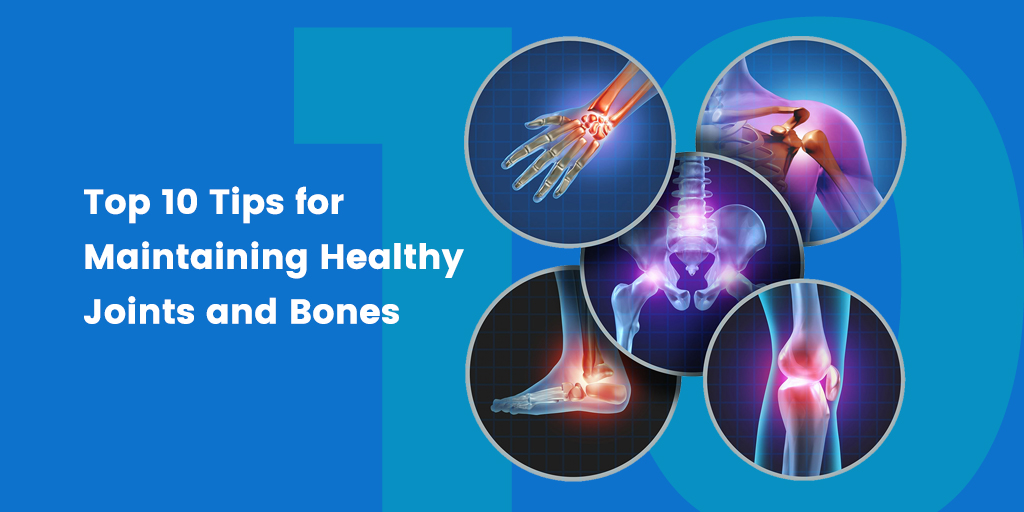Healthy joints and bones are essential for overall well-being and movement. Our joints and bones serve a vital purpose in supporting our bodies and enabling us to move freely and participate in a few activities. However, the risk of joint and bone disorders grows as we age or engage in challenging physical activities. The good news is that we can increase joint and bone health through various effective techniques and practices.
In this blog, we will look at 10 tips for keeping your joints and bones healthy, including everything from exercise and nutrition to lifestyle habits and preventive measures. By incorporating these ideas into your everyday routine, you can nurture your joints and bones, improve flexibility, and live an active and healthy life. But before diving into the tips, let us look into some common bone and joint-related diseases.
Common bone and joint-related diseases and their causes
- Osteoporosis- This is the most common type of arthritis, affecting millions of people around the world. It is caused by cartilage breakdown in the joints, which causes pain, stiffness, and inflammation. These fractures can occur anywhere, but typically in the hip, spine, and wrist.
- Fracture- A fracture is a break in a bone caused by sudden or extremely intense pressure or force. This includes falls, direct bodily impact, and sports-related injuries.
- Scoliosis- Scoliosis is an abnormal curvature of the spine resulting in an S or C shape. The disorder often occurs in a child’s growth spurt before puberty, with cases usually diagnosed in the first seven years.
- Paget’s disease- Paget’s disease is a long-term condition that alters how bones break down and grow again. This causes excessive breakdown and renewal, resulting in larger and softer bones than typical.
- Gout- Gout is a type of inflammatory arthritis that is characterized by extreme pain and is caused by an excess of uric acid in the body. Uric acid crystals form in the body’s joints and surrounding tissues. This condition normally affects one joint at a time, most commonly the one connecting the big toe.
1. Follow a regular exercise routine- Exercising is one of the most effective ways to keep your bones, muscles, and joints in good shape. Exercise of any kind, done regularly, will help you keep your bones and joints healthy.
- Weight-bearing and strength training exercises should be prioritized to assist grow stronger bones or to counteract bone deterioration as you age.
- Low-impact exercises such as swimming or cycling can enhance joint flexibility without putting too much strain on them.
2. Maintain a healthy weight- Being overweight or obese puts more pressure on your joints. This is because your joints have to work harder to maintain your weight. Losing even a small amount of weight if you are overweight or obese can help to minimize joint discomfort.
- You may relieve joint tension and promote healthier bones by regulating your weight through a mix of regular activity and a balanced diet.
3. Practice the right postures- When we maintain good alignment and posture, we transfer weight and stress equally throughout our skeletal system. This lessens the tension on specific joints and bones, reducing premature tear and damage.
Furthermore, good posture keeps our joints in their optimal locations, allowing them to move smoothly and efficiently. We reduce the likelihood of developing joint and bone-related disorders such as misalignment, arthritis, and chronic pain by not slouching or hunching over.
4. Eating a balanced diet- Choosing foods that promote bone density, connective tissue strength, and decreased inflammation can help you avoid injuries and protect your joints for a long, active life. For example, foods like fish, red meat, green vegetables, nuts, beans, and lentils are contributors to healthy bones and joints. These foods contain the calcium quantity your body requires.
5. Don’t miss your Vitamin D – Just as much as eating a balanced diet is important, allowing your body to consume Vitamin D is vital too. The core reason behind this is, Your body needs vitamin D to absorb Calcium. Good sources of vitamin D include oily fish, such as salmon, whitefish, and tuna. Additionally, mushrooms, eggs, and fortified foods, such as milk and cereals, are good sources of vitamin D. Apart from the intake of vitamin D, exposing your body to morning sunlight is also beneficial.
6. Quit smoking right away- ‘Smoking is harmful to your overall health’ is a well-known fact that can’t be denied. This harm includes affecting your bones and joints which play a major role in the movement of your body. Smoking lowers bone density, increases the likelihood of fractures, and interferes with bone repair. Quitting smoking improves bone health and lowers the chance of joint disorders.
7. Limit alcohol intake- Alcohol can harm bone and joint health in many ways. It might cause problems with calcium and vitamin D absorption, both of which are necessary for bone health. Alcohol can also harm the cells that form new bone, increasing the risk of fractures. Furthermore, drinking can contribute to inflammation, which may increase pain in the joints. For these reasons, it is generally advised that alcohol be used in moderation for optimal bone and joint health.
8. Get adequate sleep- Sleep is critical for overall wellness and also encounters a major role in bone and joint function. During sleep, the body generates hormones that aid in bone formation and repair. Furthermore, sleep aids in the reduction of inflammation, which can harm bones and joints. When you don’t get enough sleep, your body’s inflammatory markers rise. These markers can cause bone and joint degeneration, as well as worsen pain.
Finally, sleep aids in the regulation of the body’s metabolism. When you are sleep-deprived, your metabolism slows down. This might result in weight gain, which puts additional strain on your bones and joints.
9. Using the wrong muscles for certain jobs- You should inherit smart techniques when carrying something heavy or doing any kind of heavy task. When you put too much strain on little muscles, your joints pay the price. For example, If you need to open a heavy door, use your shoulder instead of your fingers.
Bend your knees and push up with your strong leg muscles while lifting something off the floor. When carrying something, keep it close to you in the palms of your hands to avoid stressing your fingers.
10. Take additional supplements- Apart from Calcium and Vitamin D mentioned above, there are some other supplements you can take to maintain healthy bones and joints. To proceed with this, it’s always advisable to get a consultation from your doctor in the first place.
- Vitamin K2- Vitamin K2 helps deliver calcium to the bone. Vitamin K2 deficiency can lead to low bone density and increase your risk of a fracture.
- Magnesium- Magnesium helps your body use Vitamin D and Calcium. Magnesium deficiencies may contribute to osteoporosis. Adequate magnesium levels can reduce the risk of fractures and promote healing.
- Collagen- Collagen is an essential protein that plays a role in everything from skin structure to blood clotting to bone health. Hydrolyzed Collagen can boost bone density and assist in osteoporosis.


